Are you a Quiet Speculation member?
If not, now is a perfect time to join up! Our powerful tools, breaking-news analysis, and exclusive Discord channel will make sure you stay up to date and ahead of the curve.
We've heard it a million times. Many of us have proudly said it ourselves. Modern's a wide-open format. Wide-open! In other words, players can sleeve up whatever they want and hope to have a chance. Well, not exactly. Players can't really sleeve up, say, Vampire Nighthawk. Like all formats, Modern follows a set of rules; creatures need to pass a playability benchmark to see play, and many archetypes already have their exemplars. There's currently little reason to play something like Esper Control with the vastly superior Jeskai deck available.

Despite these barriers, new cards and strategies break into Modern fairly regularly. Sheridan's article from this week explores how novel technology often takes the shape of precise, eyebrow-raising tweaks to known quantities, or of format staples reapplied in fresh contexts. My article today sizes up some of the bolder innovative strokes Modern has witnessed in the last month, ultimately aiming to explain why we don't see such strategies surface frequently: usually, these decks are worse versions of existing decks. Understanding why is one of the keys to brewing successfully in Modern.
[wp_ad_camp_1]
Temur Pili-Pala
Of the three decks in the article, McMartin-Rosenquist's Temur Pili-Pala seems the most viable. Not coincidentally, it also has the most impressive finish to its name. McMartin-Rosenquist also enjoyed a decent run with his brew at GP LA itself, going 6-2-1 on Day 1.
Temur Pili-Pala, by Lars McMartin-Rosenquist (1st, GPT)
Gameplan
Temur Pili-Pala is a midrange deck with a built-in combo. The list reads like a mashup of Temur Twin and Eternal Command. Full sets of Snapcaster Mage, Tarmogoyf, Remand, and Lightning Bolt make this deck highly interactive. Untapping with Grand Architect and Pili-Pala gives the deck's pilot infinite mana, best spent here on an infinite number of Whispers of the Muse and then on every spell in the deck. Of those, the Bolts probably close out most games.
Shortcomings
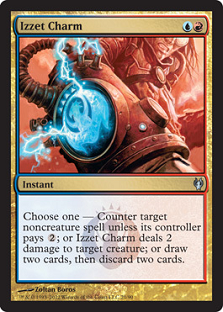 One thing I don't like about this deck is its "spacing." It has too many four-ofs. Playsets of Serum Visions and Snapcaster Mage, coupled with Temur Pili-Pala's apparent penchant for dragging things into the mid-game, would make me want to play more bullets. Spell Snare, Mana Leak, Dispel, Roast, and Izzet Charm all come to mind as cards that could slot naturally into the mainboard and provide pilots with more options throughout a match.
One thing I don't like about this deck is its "spacing." It has too many four-ofs. Playsets of Serum Visions and Snapcaster Mage, coupled with Temur Pili-Pala's apparent penchant for dragging things into the mid-game, would make me want to play more bullets. Spell Snare, Mana Leak, Dispel, Roast, and Izzet Charm all come to mind as cards that could slot naturally into the mainboard and provide pilots with more options throughout a match.
As a deckbuilder, I can understand the aesthetic appeal of a deck full of four-ofs, but I'm not sure it's warranted in disrupt-then-commit interactive shells. Midrange decks want to see a variety of cards as the game drags on.
McMartin-Rosenquist seems to have indulged me with the sideboard, which features almost only one-ofs. I think it would be healthier for the deck to spread these bullets out across the 75. In a format where 46% of the decks play four copies of Lightning Bolt, I just don't see the benefit of being as linear as possible in Game 1. That linear plan is easily disrupted by the ubiquitous instant.
Scrutinizing the Combo
The Pili-Pala combo has a glaring weakness: it doesn't necessarily win the game. Deceiver Exarch plus Splinter Twin was an infinite-damage combo that didn't die to Lightning Bolt. Pala and Architect make infinite mana, not damage, meaning they don't win the game on their own. A third card---Whispers of the Muse---is needed to secure an instant win. And that's assuming we haven't made a land drop yet, allowing us to play and activate Kessig Wolf Run with our infinite mana if the four Bolts don't get us there. Otherwise, some decks will let us play every creature in the deck, tap their Boseiju, and Ad Nauseam us to death the following turn. Without a Whispers handy, all that mana helps us dig through the deck with Serum Visions to find a Whispers, but there's no guarantee we hit it on time. Opponents can untap, topdeck Lightning Bolt, and break our combo before we get a chance to go off.
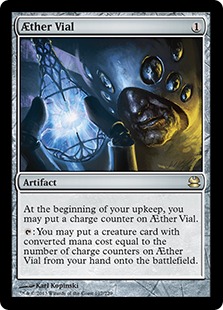 Another problem with Pili-Architect is its sluggishness. Pili-Pala needs to remain on the field for a whole turn before it can start untapping and generating mana. Twin's combo creatures don't have haste, but the deck didn't have this problem for a couple of reasons. First, Deceiver Exarch and Pestermite have flash, leaving pilots free to hold up mana and commit it to the combo whenever comfortable. Second, Twin would sometimes run Kiki-Jiki, Mirror Breaker as an extra copy of its namesake enchantment. The legendary Goblin allowed mana-flooded players to go off on an empty board, since Kiki has haste and can therefore start making tokens without needing to recover from summoning sickness.
Another problem with Pili-Architect is its sluggishness. Pili-Pala needs to remain on the field for a whole turn before it can start untapping and generating mana. Twin's combo creatures don't have haste, but the deck didn't have this problem for a couple of reasons. First, Deceiver Exarch and Pestermite have flash, leaving pilots free to hold up mana and commit it to the combo whenever comfortable. Second, Twin would sometimes run Kiki-Jiki, Mirror Breaker as an extra copy of its namesake enchantment. The legendary Goblin allowed mana-flooded players to go off on an empty board, since Kiki has haste and can therefore start making tokens without needing to recover from summoning sickness.
McMartin-Rosenquist mitigates the speed issue by playing Aether Vial. Vial lets the deck play Pili and Architect at instant-speed, and for no mana to boot. My concern with this strategy is that the combo now requires too many cards to be efficient. Pili-Pala and Grand Architect go infinite, Aether Vial gives the creatures flash, and Whispers of the Muse ensures that "infinite" actually translates into a win. These extra cards do something on their own, but that something has to prove valuable to the rest of the deck to justify inclusion---probably not the case with Whispers, and I think there's a reason we haven't seen Vial make a lot of noise in creature-light Temur shells since Shouta Yasooka's breakout performance with Eternal Command in 2012.
In comparison, Splinter Twin and Pestermite achieved all that with just two cards. With an Exarch instead, the combo even resists Lightning Bolt.
That brings us to the third major strike against this combo: its fragility. Lightning Bolt kills both Pili-Pala and Grand Architect. The combo also sustains significant splash damage from Affinity hate. Ancient Grudge is a super-efficient way to ensure the combo never gets off the ground, and Stony Silence is like a harder-to-remove Torpor Orb.
Future Positioning
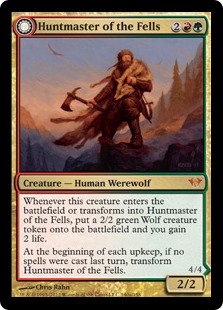 Since the Eye of Ugin ban, multiple Temur Midrange decks have been popping up, all employing the unshakable core of Snapcaster Mage, Tarmogoyf, Serum Visions, and Lightning Bolt.
Since the Eye of Ugin ban, multiple Temur Midrange decks have been popping up, all employing the unshakable core of Snapcaster Mage, Tarmogoyf, Serum Visions, and Lightning Bolt.
It seems to me like Temur Pili-Pala is a worse Temur Midrange. Pili-Pala trades some key midrange elements for the ability to play a game-winning combo. As explained above, though, I don't consider that combo Modern-level good. I haven't done any testing with this deck, but I would assume that splashing Pili-Archetect-Whispers into an otherwise reasonable Temur Midrange deck dilutes the strategy enough that it loses an unacceptable amount of points to more committed interactive decks like Jund.
Temur Twin ran the combo to have a turn-four win condition against decks like Tron that would go much bigger than Huntmaster of the Fells in the late game, and Abzan Company, which could make infinite life to bar fair decks from winning. The Pili-Architect combo still doesn't beat infinite life, and I don't think it's fast enough to put a real clock on Tron. That big mana deck has always played sweepers like Pyroclasm and Firespout, which wreck this deck's combo outside of a live Aether Vial. Tron's recent shift towards Lightning Bolt, spearheaded by Joe Losset at GP Los Angeles, makes prospects for Pili-Architect even bleaker. Splinter Twin actually solved problems for URx midrange decks, in that matchup and in others. If the main reasons to play a combo don't apply to this combo, this combo probably doesn't belong in the deck.
Monoblue Plumeveil
Okay, time to get weird. This monoblue control deck features a hefty amount of unplayed Modern cards, including the namesake threat, Plumeveil, and one bulk rare I never expected to see in any constructed format: Guile.
Monoblue Plumeveil, by k_f_chicken (4th, MTGO League)
Gameplan
This deck has a couple of angles to attack from. I'd imagine k_f_chicken secured most of his wins on the back of Vedalken Shackles alone, as that card can prove nightmarish for many aggro decks to remove. Even ones with mainboard answers, like Jund with its Abrupt Decays and Maelstrom Pulses, have trouble dealing with a full playset.
Another route to victory is to suit up Plumeveil with Warmonger's Chariot. That gives us a 6/6, flying, flash creature for just... seven mana! The coolest thing about Plumeveil is its ability to flash in during combat and kill attackers like Wild Nacatl, or even Restoration Angel. Opponents definitely won't see the Elemental coming, and I'd bet k_f_chicken took more a few games en route to his Top 8 finish thanks to the off-color removal spell a surprise Plumeveil can grant. Plumeveil also turns on ferocious for the whopping four Stubborn Denials.
 Finally, the Plumeveil deck can win by beating down with Guile. Here's a 6/6 we don't need Warmonger's Chariot for. Guile even has super-menace. But the funniest part about this creature (okay, debatable) is that he scares opponents into not casting spells. If we leave up two blue mana, opponents will fear Remand for all their life. Guile lets us cast any spell, meaning that Spell Snare won't just neutralize a Tarmogoyf, it will put it into play under our control.
Finally, the Plumeveil deck can win by beating down with Guile. Here's a 6/6 we don't need Warmonger's Chariot for. Guile even has super-menace. But the funniest part about this creature (okay, debatable) is that he scares opponents into not casting spells. If we leave up two blue mana, opponents will fear Remand for all their life. Guile lets us cast any spell, meaning that Spell Snare won't just neutralize a Tarmogoyf, it will put it into play under our control.
Out of the sideboard, k_f_chicken has even more win conditions. Master of Waves generates an enviable crew of 2/1s with a Plumeveil on board, and Spellskite slows down some decks (Bogles, Infect) so much he's practically a win condition of his own at four copies. All that said, I doubt this sideboard took more than a couple minutes to make.
Shortcomings
Like the Pili-Pala deck, Monoblue Plumeveil seems totally untuned. For one, Guile is too expensive. Six-drops are rarely played in Modern outside of ramp decks, because they don't land on time. The only one I can think of is Elspeth, Sun's Champion, whose home is a fringe control deck. Even Elspeth carries the game on her own, while Guile requires live counterspells to do anything.
Many Modern strategies want to end the game on turn four. Without cards like Path to Exile, Monoblue Plumeveil simply doesn't boast the kind of interaction necessary to consistently keep that from happening. Even decks that do, like Blue Moon with its Lightning Bolts, curve out at five mana for Goblin Dark-Dwellers and Batterskull.
The next section to doctor is the counter suite. While I'm a fan of four Spell Snare---a card also endorsed by Ryan Overturf last week---I can't get behind the "extra" Cryptic Commands, Confirm Suspicions. Five-mana counterspells have never seen Modern play for good reason: they're way too slow. Additionally, there are better options available to this deck in those slots.
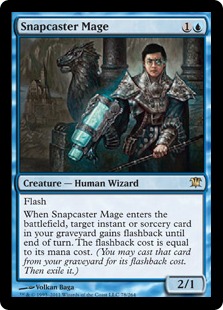 The obvious missing link is Snapcaster Mage. Here's an "extra" Cryptic I can rally behind! Snapcaster gives opponents a reason to keep in Lightning Bolt against us, plays well with the Shackles-based tempo plan, and has an ability that synergizes perfectly with this deck. Importantly, Snapcaster can come down on turn two to clock decks like Ad Nauseam, which shoot to defeat opponents long before they get to the stage of the game in which they feel comfortable slamming Guile. Getting back Remands, Snares, and Denials while sneaking in damage is another path to victory that k_f_chicken can run here at no cost to the harmony of his deck.
The obvious missing link is Snapcaster Mage. Here's an "extra" Cryptic I can rally behind! Snapcaster gives opponents a reason to keep in Lightning Bolt against us, plays well with the Shackles-based tempo plan, and has an ability that synergizes perfectly with this deck. Importantly, Snapcaster can come down on turn two to clock decks like Ad Nauseam, which shoot to defeat opponents long before they get to the stage of the game in which they feel comfortable slamming Guile. Getting back Remands, Snares, and Denials while sneaking in damage is another path to victory that k_f_chicken can run here at no cost to the harmony of his deck.
While we're adding Snapcasters, why not add Lightning Bolt? The best reason I can come up with for not splashing red in this deck is that if we did, we'd just end up with Blue Moon. That said, I think this deck is a much worse Blue Moon, so that's not much a reason not to splash red at all. Let's face it, Warmonger's Chariot on a Plumeveil is not a reliable way to win games in Modern, no matter how many Stubborn Denials we run. (Splashing white over red could also work, and would eventually yield UW Control.)
Future Positioning
Reviewing Monoblue Plumeveil made me think of my Mantis Rider decks, which looked for ways around the "Bolt test" with enchantments like Honor of the Pure. I had a lot of fun testing those decks, but found after a certain number of reps that it was much better to play good cards than it was to run bad cards in the interest of making other bad cards playable. Luckily for Monoblue Plumeveil, more coherent versions of the deck already exist in Modern, and the deck can be easily upgraded to either Blue Moon or UW Control.
Angel Control
Kyriakos20's Angel Control doesn't look a thing like you might expect it to. The tribe's single Modern-played creature, Restoration Angel, is notably absent from his list. Instead, Kyriakos20 loads up on board wipes, and hopes to dodge Terminate and Path to Exile with a full set of Baneslayer Angel. We won't delve too deeply into this list, but I found it too entertaining not to at least share.
Angel Control, by Kyriakos20 (7th, MTGO League)
Finding the Better Version
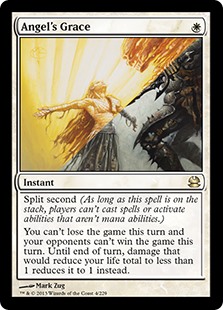 Players can't really sleeve up, say, Vampire Nighthawk.
Players can't really sleeve up, say, Vampire Nighthawk.
Or can they? In reality, players "can" play what they want in Modern. Even Guile. The above decklists put up some results, or I wouldn't have found them at all. But that doesn't mean they're optimized builds. Pushed to their respective extremes, I think Temur Pili-Pala eventually becomes Temur Midrange, and Monoblue Plumeveil evolves into Blue Moon or UW Control.
Can you guess which Modern deck Angel Control is a worse version of? Let me know in the comments. Until then, let's take a moment of silence to admire Kyriakos20's monastic dedication to the "Angel" theme.





The white red Angel deck reminds me a little bit of this build that did well at SCG Indy http://www.mtgtop8.com/event?e=12423&d=271456&f=MO
All the life gain and damage prevention also rings of soul sisters, which also has flying lifelink beaters.
There’s a strong prison element in the deck as well along side the hard hitting angels so there’s some similarity to the new death and taxes builds w/ eldrazi.
The life gain, damage prevention, and board wipes is just survival. Its seeking to make land drops until it can throw down haymakers. That’s basically Tron. Tron runs board wipes purely to buy time. The biggest differences are that Tron ramps into it’s haymakers while this deck stalls for longer and that Tron’s threats are vastly superior.
Different aspects of the last deck are all a worse and/or slower version of something. Without playing the deck, it’s tough to know which other archetype it is most similar to. My best guess is the SCG Indy list, which is itself a brew that’s worse than something else.
PS: Jordan, can you and Ryan Overturf maybe do a two part miniseries comparing and contrasting his grixis delver with your Temur grow / counter cat? I think it would be cool to learn the intricacies, nuances, and relative strengths of two similar decks from 2 pilots that know them well. Like does one have a good match up where the other has a bad one, and why are they different? What does black give vs green and how do they synergize with the UR shell differently? Stuff like that.
Not sure if requests like this are naggy or if it is helpful to you.
Yep, the WR Control deck is the one I had in mind. I think Nahiri and Ajani are better proactive cards than Guardian Seraph and Baneslayer Angel, and the WR Control deck improves its interaction by dipping into red a little more for Helix (at virtually no cost to its own consistency) and running Guide/Chalice.
It might be interesting to go into the differences between Temur and Grixis Delver with Ryan, but off the top of my head, here they are, as I understand them:
Temur:
– Has trouble transitioning to a midrange plan in Game 1
– Makes up for this weakness by playing a superb tempo game
– Favorable matchups vs. every linear deck, struggles vs. midrange
– Better SB cards, i.e. Huntmaster
Grixis:
– Slower and clunkier, better geared for the mid-game than the early-game
– Essentially a Grixis Control deck that “splashes” Delvers so it doesn’t auto-lose to linear strategies
– Can struggle vs. stuff like Tron and Burn, but has a great time vs. midrange
– Better mainboard spells, i.e. Terminate
In the end, the deck you play comes down to personal preference, since they both handle so differently. But I do think each is better suited to a different metgame. Since Modern is so linear, I’m inclined to say Temur is better positioned in a diverse field. But if you expect a ton of Jund, and not a lot of Burn/Tron/Bogles/etc., you’re way better off playing Grixis.
Angel control is in the wheel of skred red I think. Maindeck blood moon and a bunch of hate cards and sweepers and go over the top once you’ve soft locked or slowed them down (bsa vs koth and stormbreath).
I feel like with the pili-pala combo you’re forgetting you also draw 4 snapcasters…so it’s really plenty of burn in the deck
4th turn with 4 mana untapped… you cast grand architect for 3, then tap G.A. to gain 2 mana for artifcats, then cast pili-pala and make it blue with the remaining 1 blue and you go infinite!
pili pala will have summoning sickness. it can’t use it’s untap effect. see rule 302.6
I like the Plumeveil concept; given the colour of the name-sake card White would seem the best secondary colour for Path, Verdict and better sideboard options. Given its 5-0 finish I would be interested to see what a tuned version with Snapcaster could achieve.
Emeria Control is another deck I could think of that might be able to make use of Plumeveil; Warmonger’s Chariot may not add much to that deck though.
WR Angels is half WR Pillow Fort (Leylines, Blood Moon) and half Tron (Wipes, Fatties). Either deck is likely to be better .
In the Pili-Pala deck: drawing Kessig wolf run with infinite mana means giving at least +1000000/+0 and “Trample” to a creature: I think it’s enough damage to end each game. It’s almost an instant win. It doesn’t rely only on burn plus snapcaster.
“Pala and Architect make infinite mana, not damage, meaning they don’t win the game on their own. A third card—Whispers of the Muse—is needed to secure an instant win. And that’s assuming we haven’t made a land drop yet, allowing us to play and activate Kessig Wolf Run with our infinite mana if the four Bolts don’t get us there.”
Kessig still taxes us a land drop, potentially slowing down the combo by a turn.